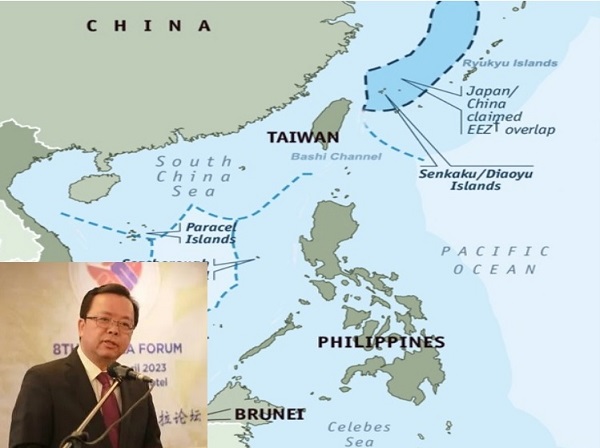
It was short and clear. And combative.
In 10 paragraphs, Chinese Ambassador Huang Xilian made known last Sunday, April 16, his government’s anger over the decision of President Ferdinand Marcos Jr. allowing the United States military to preposition and store defense equipment, supplies and materiel in sites “only a stone’s throw away from Taiwan.”
He warned what China, which boasts of the strongest military in Asia and third in the world, might and can do: “… we will not renounce the use of force, and we reserve the option of taking all necessary measures.”
He laid out to the Marcos government how it could be affected adversely in case armed hostilities erupt in Taiwan, where over 150,000 Filipinos work, and what it should do to help prevent that situation from happening: “The Philippines is advised to unequivocally oppose ’Taiwan independence’ rather than stoking the fire by offering the U.S. access to the military bases near the Taiwan Strait if you care genuinely about the 150,000 OFWs.”
Two weeks earlier, when the pre-dominantly Catholic Filipinos were starting their observance of the week-long Holy Week retreat, the government released the location of the additional four EDCA sites: Lal-lo Airport in Cagayan; Camilo Osias Naval Base in Santa Ana, Cagayan; Camp Melchor dela Cruz in Gamu, Isabela; and Balabac Island in Palawan.
EDCA stands for Enhanced Cooperation Agreement between the Philippines and the United States signed in 2014 which established “agreed locations” in the country where the United States Armed Forces can have access on a rotational basis.
Under EDCA, “the Philippines authorizes the United States forces, United States contractors and vehicles, vessels and aircraft operated by or for United States forces may conduct the following activities with respect to Agreed Locations: training, transit, support and related activities; refueling of aircraft, bunkering of vessels; temporary maintenance of vehicles, vessels and aircraft; temporary accommodation of personnel; communications; prepositioning of equipment, supplies, materiel; deploying forces and materiel and such other activities as the Parties may agree.”
The four new sites bring to nine the EDCA sites in the country. The five earlier agreed locations are Cesar Basa Air Base in Pampanga, Fort Magsaysay Military Reservation in Nueva Ecija, Lumbia Air Base in Cagayan de Oro, Antonio Bautista Air Base in Puerto Prinsesa and Mactan Benito Ebuen Air Base in Cebu.
The two sites that are driving China up the wall are Lal-lo Airport in Cagayan, which is 590 kilometers to Taiwan, and Camilo Osias Naval Base in Santa Ana, Cagayan, which is 623 km to Taiwan.
The ambassador explained: “Obviously, the U.S. intends to take advantage of the new EDCA sites to interfere in the situation across the Taiwan Strait to serve its geopolitical goals, and advance its anti-China agenda at the expense of peace and development of the Philippines and the region at large. Many Filipino politicians and ordinary Filipino people are questioning whether opening new bases will serve the national interests of the Philippines. ’Why are the new EDCA sites only a stone’s throw away from Taiwan?’ ‘How will the Philippines effectively control the prepositioned weapons in the military bases?’ ‘Why will the Philippines fight for another country through the new EDCA sites?’ These are soul-searching questions of the Philippine people and also doubt by people in China and across the region.”
That’s when he raised the worrisome possibility: “But we will not renounce the use of force, and we reserve the option of taking all necessary measures. This is to guard against external interference and all separatist activities. The Philippines is advised to unequivocally oppose ’Taiwan independence’ rather than stoking the fire by offering the U.S. access to the military bases near the Taiwan Strait if you care genuinely about the 150,000 OFWs.”
On April 10, Marcos said he will not allow the EDCA sites to be used in any offensive attack. He added in Filipino, “If no one attacks us, they don’t need to worry because we won’t fight them.”
Taiwan is one of China’s core issues. Since 1949 when the then Mao Tse Tung-led Communist Party of China took over the mainland after more than two decades of civil war and pushed the Chiang Kai shek-led Nationalist Party of China to Taiwan – an island about 100 miles away – the Beijing government has made the One-China Policy a pre-requisite in its relations with other countries.
Under the One-China Policy, which the Philippines, the U.S. and more than 180 countries have adopted, the Beijing-based People’s Republic of China is the legitimate government of China and Taiwan is a province of China.
For many years, the world has seen peace under a delicate situation of “no unification, no independence, and no use of force” policy. In recent years, however, Beijing finds Taiwan under President Tsai Ing-wen leaning more towards independence.
Two years ago, I asked a Chinese journalist about the possibility of an armed confrontation over Taiwan, he said, “Not in our lifetime.”
Last month, I asked him the same question. His answer: “I’m not sure anymore.”